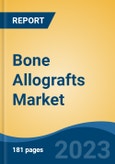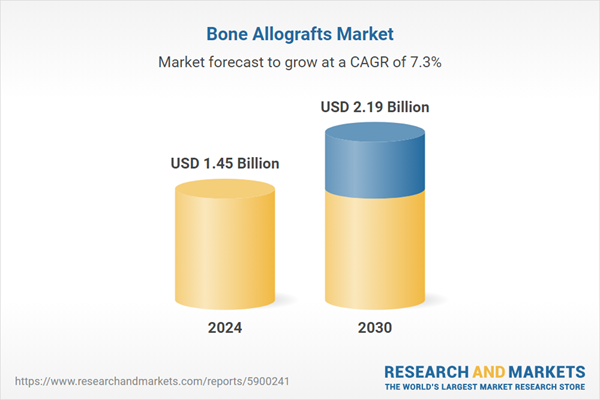Speak directly to the analyst to clarify any post sales queries you may have.
10% Free customizationThis report comes with 10% free customization, enabling you to add data that meets your specific business needs.
They are primarily employed in surgeries to treat bone defects, fractures, spinal fusion, joint reconstruction, and dental procedures. Bone allografts serve as a viable alternative to autografts (bone tissue from the patient's own body) and have gained popularity due to their ability to promote bone healing and reduce pain and recovery time. According to a 2024 article, an estimated 63% of individuals aged 75 to 84 in the United Kingdom were living with a musculoskeletal condition, the highest prevalence among all age groups. Overall, the prevalence of musculoskeletal conditions tends to rise with age, highlighting the significant impact on the elderly population.
The global prevalence of orthopedic disorders, including osteoarthritis, fractures, and spinal deformities, is on the rise. This trend has fueled the demand for bone allografts, as they are crucial in surgical interventions to address these conditions. Technological advancements in surgical techniques, such as minimally invasive surgeries and robotic-assisted procedures, have increased the adoption of bone allografts. These techniques enhance the precision and efficacy of bone grafting procedures.
The aging population is prone to age-related bone issues, such as osteoporosis and degenerative joint diseases. As the elderly population continues to grow, the demand for bone allografts is expected to rise significantly. Stringent regulatory frameworks governing tissue transplantation have improved the safety and quality of bone allografts. This has bolstered consumer confidence and market growth. Increased awareness among both patients and healthcare professionals about the benefits of bone allografts has led to higher acceptance and utilization of these grafts in surgical procedures.
Key Market Drivers
Rising Incidence of Musculoskeletal Disorders is Driving the Global Bone Allografts Market
Musculoskeletal disorders have become a significant global health concern, affecting millions of people across the world. These disorders encompass a wide range of conditions that impact the muscles, bones, tendons, ligaments, and other parts of the musculoskeletal system. Conditions like osteoarthritis, osteoporosis, fractures, and spinal disorders have been on the rise due to various factors such as aging populations and sedentary lifestyles. To address the growing demand for musculoskeletal treatments, the global bone allografts market is experiencing remarkable growth.Musculoskeletal disorders represent a wide spectrum of health issues, and their prevalence is increasing at an alarming rate globally. As the world's population ages, the incidence of musculoskeletal disorders, particularly osteoarthritis and osteoporosis, is rising. Aging leads to a natural loss of bone density and muscle mass, making individuals more susceptible to fractures and joint degeneration. Modern lifestyles often involve extended periods of sitting, limited physical activity, and poor posture. These factors can contribute to muscle imbalances and musculoskeletal problems, including back pain and repetitive strain injuries.
Obesity is a significant risk factor for musculoskeletal disorders. Excess weight places additional stress on joints, leading to conditions like osteoarthritis and lower back pain. Jobs that involve repetitive motions, heavy lifting, or prolonged periods of standing can lead to musculoskeletal injuries. Workers in industries like construction, healthcare, and manufacturing are at a higher risk. Participation in sports and physical activities carries a risk of injury, including fractures and ligament tears, which can contribute to the overall burden of musculoskeletal disorders.
Key Market Challenges
Supply Chain Constraints
One of the primary challenges facing the bone allografts market is the consistent and reliable supply of graft materials. The availability of suitable donor tissues can be affected by factors such as changes in regulations, limitations on donor pool size, and disruptions in the supply chain due to natural disasters or health crises like the COVID-19 pandemic. Ensuring a stable supply chain is essential to meet the growing demand for bone allografts.Key Market Trends
Technological Advancements
Technological advancements have always been a catalyst for innovation and growth in various industries, and the healthcare sector is no exception. In recent years, the global bone allografts market has witnessed a remarkable surge in demand, thanks to the continuous evolution of cutting-edge technologies. Bone allografts, which involve the transplantation of bone tissue from a donor to a recipient, have become a crucial component in various orthopedic and dental procedures.Also, the partnership between two companies leads to the growth of global bone allografts market. For instance, in August 2022, Orthofix Medical Inc., a medical device company, collaborated with CGBio, a developer of synthetic bone grafts, to commercialize and advance the clinical development of Novosis recombinant human bone morphogenetic protein-2 (rhBMP-2) in the U.S. and Canadian markets.
Key Market Players
- Zimmer Biomet inc.
- Medtronic inc.
- Lynch Biologics, LLC
- Biomatlante S.A
- Stryker Corporation
- Royal Biologics, Inc.
- Johnsons & Johnsons
- Smith & Nephew plc
- Baxter International Inc
- Xtant Medical Hldgs.
Report Scope:
In this report, the Global Bone Allografts Market has been segmented into the following categories, in addition to the industry trends which have also been detailed below:Bone Allografts Market, By Application:
- Dental
- Spine
- Reconstruction & Traumatology
- Others
Bone Allografts Market, By Type:
- Cortical Bone Allografts
- Cancellous Bone Allografts
- Corticocancellous Bone Allografts
- Demineralized bone Matrices
Bone Allografts Market, By End-user:
- Hospitals & Dental Clinics
- Orthopedic & Trauma Centers
- Others
Bone Allografts Market, By Region:
- North America
- United States
- Canada
- Mexico
- Europe
- France
- United Kingdom
- Italy
- Germany
- Spain
- Asia-Pacific
- China
- India
- Japan
- Australia
- South Korea
- South America
- Brazil
- Argentina
- Colombia
- Middle East & Africa
- South Africa
- Saudi Arabia
- UAE
Competitive Landscape
Company Profiles: Detailed analysis of the major companies present in the Global Bone Allografts Market.Available Customizations:
With the given market data, the publisher offers customizations according to a company's specific needs. The following customization options are available for the report.Company Information
- Detailed analysis and profiling of additional market players (up to five).
This product will be delivered within 1-3 business days.
Table of Contents
Companies Mentioned
- Zimmer Biomet inc.
- Medtronic inc.
- Lynch Biologics, LLC
- Biomatlante S.A
- Stryker Corporation
- Royal Biologics, Inc.
- Johnsons & Johnsons
- Smith & Nephew plc
- Baxter International Inc
- Xtant Medical Hldgs.
Table Information
| Report Attribute | Details |
|---|---|
| No. of Pages | 182 |
| Published | March 2025 |
| Forecast Period | 2024 - 2030 |
| Estimated Market Value ( USD | $ 1.45 Billion |
| Forecasted Market Value ( USD | $ 2.19 Billion |
| Compound Annual Growth Rate | 7.2% |
| Regions Covered | Global |
| No. of Companies Mentioned | 10 |









